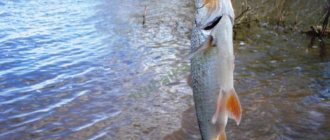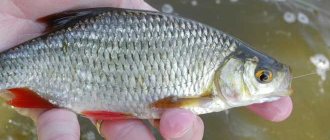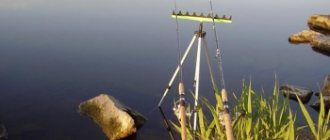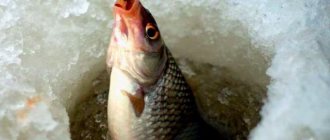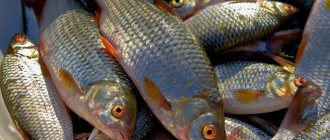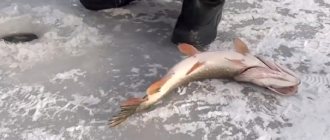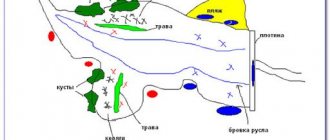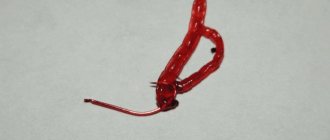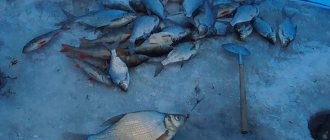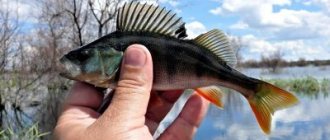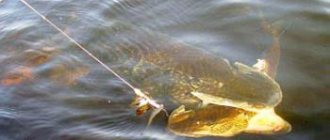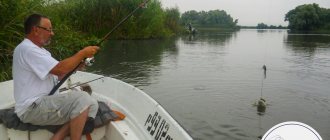Catching roach, especially during open water, is exciting and interesting; you can learn about what and how to catch this fish by reading the article to the end.
Immediately after the ice melts, the roach moves closer to the bays and to coastal zones, where the depth does not exceed 1.5 meters. Why? The fact is that the water here warms up faster and is enriched with oxygen.
Fishing time
Starting from the end of the climatic winter (in different regions this happens at different times), fresh water enriched with oxygen begins to actively enter the reservoir, while the turbidity of the water also increases, which certainly leads to an increase in fish activity. But before the fish are fully active, the water temperature is not enough, which, with a relatively rapid increase in air temperature, clearly lags behind. Due to the fact that water cannot heat up as quickly as air, the fish is still quite sluggish, and its bite is not predictable. Later, when the reservoirs open up, the water level rises, the floodplain overflows, and here the fisherman must not miss the moment when he can start catching spring roach.
On the river in the spring, large roaches begin to bite first, and most often this happens in places of a flooded floodplain with shallow depths - no more than 150 cm, with a weak current, or where there is no current at all.
This is due to the fact that in such places the water warms up faster, while the water does not lose its freshness in terms of oxygen content in it, in addition, there is more food for it than in the riverbed part of the river. Here, there are quite often areas where the willow grass grows; somewhere, last year’s reeds become flooded, which, of course, attracts almost all the fish, including roaches.
Where to catch roach in spring
Roach is a schooling fish; these cheerful friends need a lot of space, and they often stay on vast river reaches with a flat bottom, where the current is not very fast. A large school usually avoids strong eddies and backflows that prevent the fish from sticking together. But when the roach disperses, it becomes almost omnipresent. Thus, wonderful places are located on sharp river turns, where the channel current rolls onto the shore. Large roaches really like to feel completely safe, and it’s good if there are some bushes in the water, grass, or just a neighborhood of deep holes near the chosen fishing spot. The main working roach depths are 1.5-2 m.
In warm May, you can prepare good fishing spots yourself. This method is practiced on many rivers: a fisherman goes into the water up to his waist, drives a couple of stakes into the bottom soil, and a piece of slate about 1 m long and about 50 cm high is lowered in front of them. It is pressed against the stakes, creating a kind of man-made threshold that slightly blocks the flow . The roach really likes such places; they add bait over the threshold and successfully catch large fish.
Fishing place
It is preferable to go fishing in a place where the flooded talnik or reeds ends , and that the depth at the fishing site is no more than 150 centimeters. In this case, it is better to choose a more or less flat bottom, since during the period of flooding there is a lot of last year’s grass in such places, and the smoother the table is, the easier it will be for the roach to detect the bait, there will be fewer snags, and in general it will be more comfortable.
It should be especially noted that in such places there is often such a phenomenon as a reverse current; every angler knows that this factor has a particularly positive effect on the quality of fishing, since it is precisely such turbulences that bring natural food to this place, which undoubtedly attracts roaches. The above effect is more permanent than, say, targeted feeding of a given point by an angler. Roach is a schooling fish, it can stay both in the bottom layer and in the water column, and in such a place it will be quite easy to determine its movement by checking different depth levels with a float rod.
The second most attractive place for catching roach in the spring is a river backwater. It is preferable to fish from the peninsula spit towards the backwater, where there is no current, and the sharper the spit, the better, since the current is stronger here, and therefore the likelihood of a reverse current forming into the backwater area will be greater. On site, this can be visually determined by small whirlpools with leaves, brushwood, insects and their larvae, in which roach food items also gather, attractiveness according to the principle described above.
We also select a place with shallow depth and a relatively flat, preferably hard bottom, depending on your luck, and place the float rod so that the float does not spin in the whirlpools, but is in one place, 2-3 meters from the edge of their border. After which we begin to look for roach, and if found, we begin fishing in the place where the first one was caught.
The third place in order, but not in importance, is the confluence of a small stream into a river or backwater, even into a lake. As a rule, in the spring the streams are also full of water, but the water in them is warmer and carries a lot of food.
At the point where it flows into a larger body of water, sediment is formed, with a difference in depth at the point where the stream flows out. The created relief feature creates an attractive environment for roach, and it stays there, picking up food brought by the warm water of the stream. In my opinion, a very promising place.
The process of catching roach looks like this
I take light bait, squeeze it in my hand, forming a small ball, and throw it where the float will float. When it hits the water, the lump should crumble and be carried down by the current in the form of a cloud. In this way I attract fish from a distance of at least 50 m. I throw the float several times during each swim, gradually reducing the frequency to one throw per 3-4 retrieves. When the fish approaches, the bottom feeding holds it, and I stop feeding with “dust”. I do it simply. I moisten the ground crackers a little so that they remain a little dry. Then I add freshly ground seeds, mix thoroughly, then grind through a large-mesh sieve, making the food “airy” and crumbly.
Usually the first fish that can be caught in this way is a chub, only then a roach (sometimes a large bream) approaches. And the bottom fishers sitting nearby cannot believe their eyes that in this place, near the shore, you can catch such a respectable fish with a float rod!
As for the lap dog, lately I have been avoiding this method of long-distance guiding; it can be difficult to find a suitable place - everything around is occupied by donks! Plus three more disadvantages: it is almost impossible to fish normally when the wind is blowing downstream; a lot of hooks; There is a lot of red tape with bait. However, a lapdog often comes to the rescue when it is impossible to reach fish sites with a fly rod or when you need to guide along a heavily bushy shore, near a strip of algae. The advantages of this coastal wiring are noticeable on a large spring river when using a long rod, I have a “seven”. Match reel size 3000, main line 0.14 mm, leader 0.12 mm. I use hooks from 14 to 18 numbers, a float of 5-7 g. It is slightly underloaded, the “cap” of the body sticks out of the water (the shape of a float in the shape of a carrot, the wide part up), the antenna is 3-5 mm thick. I connect the fishing line through a swivel to a leash 50-70 cm long. Twenty centimeters from the hook I clamp a signal pellet weighing 0.3 g. The distance from the hook to the float is about half a meter greater than the depth.
After casting, I rest the rod on my thigh with the tip up, from there to the float the entire line is suspended - nothing lies on the water! The current does all the work for me, I just control the passage of the float.
I only use bait for roach that holds firmly on the hook: maggot, shitik, leech, because their contact with the bottom when retrieving is quite hard.
If the month of May is warm and sunny, then I can sit on the shore with a feeder. With this gear, catching roach on the river is convenient and promising. The bites of large roach from the bottom are aggressive and bold. Feeder krupnyak requires only two things. First, the hook size is no more than No. 16-20. Secondly, it is very advisable to add at least a little maggot or caster to the plant bait. As for the length of the leash, the most popular one for me is 25-30 cm - longer ones did not give a significant increase in bites in the spring.
Tackle
The roach can stay there for a long time without moving, so the main thing here is to remain quiet, the trickle will do the rest for you. Here you can equally successfully catch roach both with a feeder rod with a simple sinker without bait, and with a float rod. You need to focus on the boundary of calmer water and current; as a rule, such a boundary can be determined visually.
Bait
Bait in the spring, of course, should be animal, the roach is recovering from the winter period, and it needs to get itself in order as soon as possible, so earthworms, dung worms, maggots would be preferable as bait; if the roach is very weak, perhaps bloodworms will help stir her up. It is necessary to be especially sensitive in determining not only the type of nozzle, but also its size. The colder the water, the more delicate, in my opinion, the bait should be, therefore, the hooks should be smaller and thinner, in such conditions I try not to experiment with a combination of baits - maggot with bloodworms, maggot with a worm - as a rule, this does not help , but on the contrary, it repels even large roaches. If the water has warmed up quite well, you can experiment with both the type and size of the nozzle.
If there is some kind of constant bite, you can gradually try to increase the size of the bait - a larger worm, if you are fishing with maggots or bloodworms, then you can gradually add their quantity to the hook and monitor the changes, you can also combine baits. Of course, it is better to catch roach during this period in favorable weather conditions, on sunny days, preferably without wind; we must not forget about pressure.
What do you use to catch roach in the spring?
The roach falls for almost everything that the fisherman offers it, even a large crawler, even a piece of dung worm, but I always remember that the main food of even a large roach is small in size - bloodworms, shitik, and other larvae living in the water. In the spring I will put bloodworms and shitica first. Then comes maggots (or casters, I fill them with water so they don’t darken). In third place are bread (bread dough, crust) and steamed wheat. In general, as for plant baits, they perform best closer to summer, in warm water.
If I fish with fly tackle, I use a six-meter rod. Thin lines are very important for success! The main line is 0.12 mm. Leash – 0.08 mm. Hook number 20-22. Float 0.75-1 g, no more.
Two types of bait. The first is an ordinary river mixture, heavy, holding securely to the bottom. The second type is light, “dusty”, without weights; the current carries it in the form of a cloud in the upper layers of the water.
At the chosen place, I check the depth with the tackle to see if there are any snags on the bottom, and set the working descent - the leash with the nozzle should lightly scratch along the bottom. I throw heavy bait into the area where the float passes - pearl barley, wheat, broken shells, whatever I have. I sometimes use an original feeder as bottom bait: I string 10-15 large worms onto a piece of wire, twist the wire into a ring, tie a thick fishing line and throw it to the fishing point. You can take out such a simple feeder, check it, and add worms if necessary.
Lure
Regarding bait, it should be said that the best bait is not too aromatic, with the obligatory addition of a large amount of animal component, preferably corresponding to the one for which the fish is being fished; the addition of soil in the spring is obligatory. If the bait mixture is too aromatic, then the roach will simply leave altogether, this has been repeatedly noticed and confirmed by many years of observations - in a word, in the spring you cannot overdo it with bait, it’s better to have a little, and it’s better to keep more animal than vegetable.
Feeding
In general, when choosing the right place, where, by all signs, there should be a roach, after its discovery, by catching it, you must first try not to scare away the entire flock. In this case, it will be more useful to throw a small handful of the bait that you are using as bait at the fishing point, so you will not scare away the fish that is already in the fishing zone, since the sound from the fall of such bait will be minimal, and its component has been proven to attract roaches Here and now. And only if a constant bite occurs, you can mix such a bait with the soil in order to deliver the bait more accurately, and more carefully, a little at a time, do not feed the place often, the main thing is not to overdo it.
Roach habits
In spring, roach behaves rather lazily, its bites differ from the sharp ones in summer. In the spring, the roach slightly lowers it into the water, leads it to the side, and can even drown it, but not as sharply as can be observed in the summer. Therefore, I try not to fish with a feeder, and bites on a feeder happen much less often than on a float rig, even if the fishing is carried out in the same place and at the same distance.
Catching roach in spring - equipment, fishing methods and the best bait
When does spawning begin and the first roach bites?
They fish all year round, only the equipment used is changed. As soon as the water begins to break away from the ice, you can get a summer fishing rod. Lures are launched as soon as the ice begins to drift. In the spring, as the water temperature rises, the quantity and quality of bait will only increase, gradually moving into the pre-entertainment period.
Spawning occurs in May, so it is important to start fishing before May. In early spring, look for cockroaches in shallow and shallow water. These fish move in herds and wade small rivers and streams. Biting activity is constantly changing and you should move around the pond frequently to look for areas where fish are stopping or feeding. You need bait, but that won't hold the magpie for long.
What should you fish for?
To replenish energy reserves and gain energy, roach, like any other organism, needs high-calorie food. In March, when the water is still very cloudy and there are a lot of bites, it is important to choose a place and bait. You should fish in shallow water where the spring rays warm the water better. Often bait is better where there is little current and shallow depth.
Animal baits are the preferred bait:
Red Worm – Available in stores year round Gizzard is the best bait for the entire spring. Roach is great for March. For a large fence, a chum or a bunch of chums is suitable. Dragonfly larvae are only available in April.
The following types of plants are also allowed:
Steamed pearl millet is a classic from spring to autumn. Swollen wheat is not so good, but in some waters it is simply necessary. white bread Large dough balls to cut the bait Manuka from a syringe is also indispensable. Polystyrene foam balls rising above the bottom attract the attention of not only wobblers, but also other fish.
Since it is visually difficult to find the bait (due to the turbidity of the water), you can resort to using flavorings (dips) - read about them below. They are needed to make it easier for fish to find the bait by smell. If there are no bites, change baits or use the “sandwich” technique: attach several different baits to the hook at the same time.
What bait to use
There are unspoken rules for rigging bait that significantly increase your catch:
Large quantities of live food should not be used as bait from early March to mid-April. Otherwise, this will lead to the fish quickly becoming saturated and leaving the place where they were caught. Due to the still low temperature, metabolism is slow, so do not overfeed the roach. In May, before spawning, you can do without bait, because the fish attack anything that looks like food. But you should still understand that if there are a lot of fishermen around, you definitely need to attract fish to your point.
You can prepare the mixture yourself using one of the following recipes:
- Mix the purchased bait with breadcrumbs and ground seeds. Use only ready-made baits on the fence. Millet, for example millet with crushed worms. If we are fishing with a float rod, we can make a few casts of the feeder on a bloodworm, bloodworm or worm.
Universal bait can be prepared at home using the following recipe:
1/2 kg breadcrumbs 1/2 kg bran 4-5 tablespoons milk powder Oatmeal - until desired consistency is achieved
Breadcrumbs and milk powder act as a “cloud of dust” that floats in the bait, attracting the attention of cockroaches. This effect is especially attractive after the main body of water has settled. After the small balls are rolled, a starting throw of 3-4 pieces is made.
